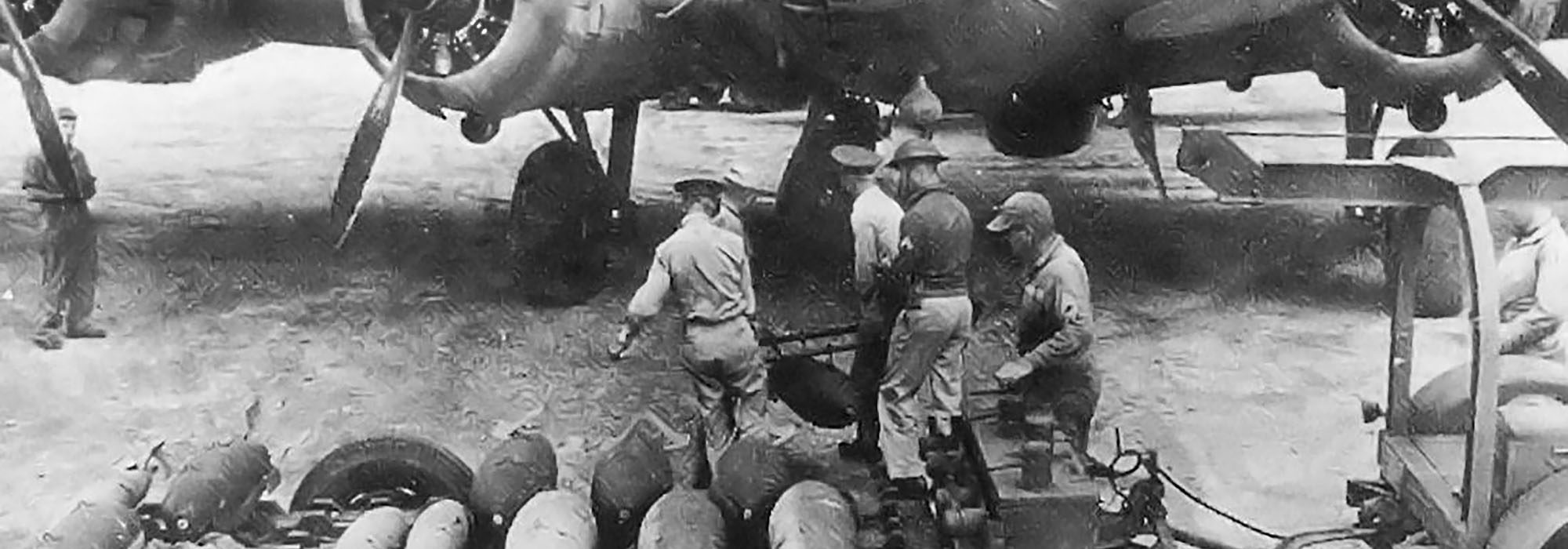For the bravery displayed on this final mission, Pease was awarded the Medal of Honor, presented to his father by President Franklin D. Roosevelt at the White House.
In 1957, Strategic Air Command bestowed a new name upon its largest New Hampshire bomber base. Portsmouth Air Force Base became Pease Air Force Base, in honor of Capt. Harl Pease Jr.
Thus did Pease, a local boy, enter the pantheon of SAC heroes.
Pease, born in 1917 in Plymouth, N.H., enlisted as an Air Corps cadet on Sept. 23, 1939, and received his wings in June 1940. Pease went straight to the Pacific. He regularly flew in mass-formation flights of B-17s, exploits for which he was awarded a Distinguished Flying Cross.
Pease’s outfit, 19th Bomb Group, was based at Clark Field, Philippines, when Japan struck on Dec. 8, 1941, starting the War in the Pacific. What was left of the group redeployed to Australia.
Soon, the 19th BG marshaled 10 B-17s—Pease was one of the pilots—to strike enemy forces in Java, a heroic but futile effort to check Japan’s advance. From Australia, Pease began flying combat and resupply missions to the Philippines some 2,500 miles away. For this, he was awarded a second DFC.
In May, Pease took part in the first Battle of the Coral Sea, flying grueling 16-hour missions to bomb targets on New Guinea.
Greater heroics lay ahead. US Marines were planning to storm Guadalcanal on Aug. 7, but feared Japanese air attack from Rabaul, New Britain. The 19th BG ordered a “maximum effort” bomber raid from Port Moresby on Aug. 7 to knock out Rabaul’s air threat.
In a turn of bad luck, however, Pease’s B-17 on Aug. 6 lost an engine, and was forced to return to Australia. It looked as if Pease would miss the big show, but he was determined to make it.
Pease located a beat-up B-17—#41-2439. Its engines were in disrepair and some armament was missing, but it was available. Somehow, Pease and a volunteer crew got it in flying shape and took off for Port Moresby. They arrived at 1 a.m. and slipped into position.
Showing great flying skill, Pease kept his aircraft in formation all the way to Rabaul, where it accurately unloaded its bombs and shot down several Japanese fighters on the way in.
On the way out, however, Pease’s ramshackle B-17, which had taken major battle damage, couldn’t keep up; the other B-17s pulled away and dove into clouds. Pease’s B-17 never made it. Enemy fire ignited a fuel tank, and that was the last anyone saw of #41-2439.
Because Pease and his crew did not return, officers concluded the B-17 had been shot down with all hands lost. Only after the war did the Air Corps learn that Pease and another crew member had bailed out and were captured. On Oct. 8, 1942, they were executed.
For the bravery displayed on this final mission, Pease was awarded the Medal of Honor, presented to his father by President Franklin D. Roosevelt at the White House.
While Pease Air Force Base closed years ago, a smaller Pease Air National Guard Base operates on the site. It is home to the New Hampshire Air National Guard’s 157th Air Refueling Wing, which was one of the first units to acquire USAF’s new KC-46 tanker. A civilian airport occupies part of the old Active Duty base.

Harl Pease Jr.
Born: Apr. 10, 1917, Plymouth, N.H.
Died: Oct. 8, 1942, Rabaul, New Britain
College: University of New Hampshire
Occupation: US military officer
Services: US Army Air Corps, US Army Air Forces
Main Era: World War II
Years of Service: 1939-42
Combat: Pacific Theater 1941-43
Final Grade: Captain
Honors: Medal of Honor (awarded posthumously), Distinguished Flying Cross (2), Prisoner of War Medal (awarded posthumously), Purple Heart (awarded posthumously)
Resting place: Body not recovered

Pease Air National Guard Base
State: New HampshireNearest City: Portsmouth
Status: Mixed use (Air National Guard, civilian)
Original Area: 6.4 sq mi / 4,100 acres
Site conveyed to USAF: 1951
Opened as Portsmouth AFB: June 30, 1956
Renamed Pease AFB: Sept. 7, 1957
Closed (by USAF): March 31, 1991
Pease ANGB opened: July 1991
ANGB area: .33 sq mi / 220 acres
Current owners: New Hampshire ANG, Pease Development Authority
Former owner: Strategic Air Command
Home of: 157th Air Refueling Wing (ANG), includes 64th Air Refueling Squadron (active USAF)
